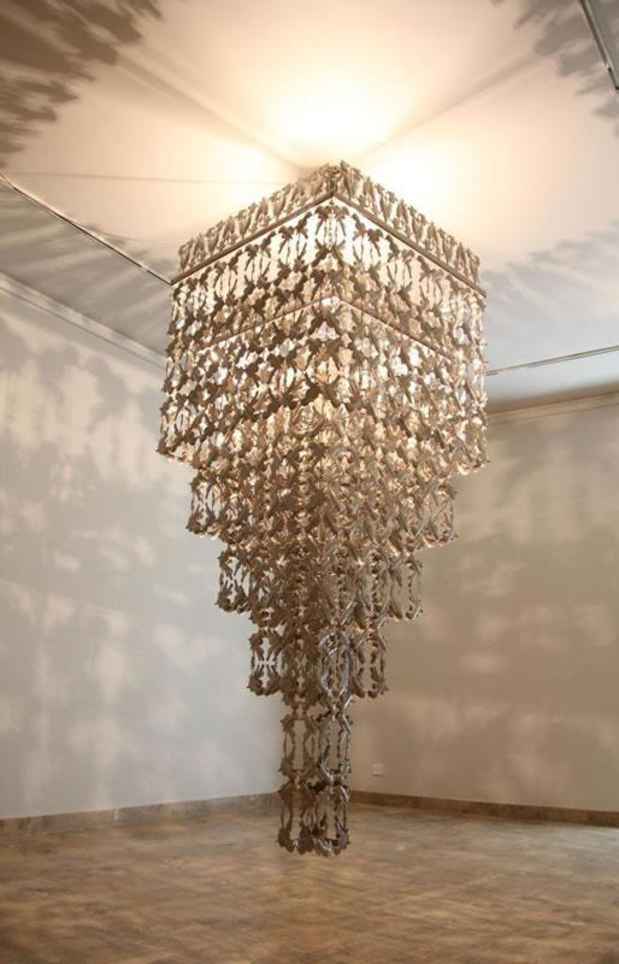Adeela Suleman “Towards the End”
Aicon Gallery

This event has ended.
Aicon Gallery presents recent works by Adeela Suleman in her second New York solo exhibition, Towards the End. The exhibition hinges around a new group of monumental hand-beaten steel reliefs, rendered in the hammered metal-working tradition of Islamic art, depicting beheaded figures engaged in violent, but also absurd, scenes of armed conflict. Suleman remains thematically and materially consistent with her previous New York show, “After All It’s Always Somebody Else…”, but formalistically her work conveys a new sense of urgency.
From the Paleolithic into Neolithic eras, prehistoric humans shaped stone tools amid a progression of cultural and technological developments. Neolithic domestication led to permanent settlements, refining crafts such as pottery and weaving, to ultimately give rise to Bronze Age metallurgy. The emergence of metal tools advanced the technology of early civilization, including the first modern tools of war. In history, warriors are often portrayed with favored armaments - swords, lances, bows, shields, guns - adorning suits of protective armor. Arms not only provide visual evidence of a soldier’s capacity and stature, but also testify to his established role in the social hierarchy.
In the Mubarizun - No More series, Suleman portrays soldiers in binary identities, simultaneously as decorated heroes and headless entities of war. Depictions of senseless killing lead to scenes of violent chaos and anarchy, rather than exploring the alternatives of altruistic reason and harmony. Decapitated soldiers march purposefully to battle, yet are unable to comprehend why. Historically, the term “mubarizun” (translated: duelers, or champions) referred to an elite unit of the Rashidun army comprised of top warriors - the master swordsmen, lancers and archers of their time. The Mubarizun were a recognized branch of the Muslim army, its sole purpose to slay as many opposing commanders, often in a duel preceeding the battle, for the purpose of demoralizing the enemy. In Mubarizun - No More Series 1, Suleman portrays two soldiers on a bed of flowers after beheading each other, with petal-like blood drops spraying from their severed necks as a crow sits unaffected upon one of the figures. The sculptures address, among other things, the archetypal history of human violence, paired with the inherent ambivalence of modern warfare, where killing on both small and large scales has become increasingly depersonalized and ambiguous in terms of accountability.
Suleman’s metal sword series, Karr Wa Farr, also incorporates the iconography of early Islamic warfare. Literally translated, “karr wa farr” means attack and flee, which was an early Arabian cavalry tactic. To weaken the enemies, infantry would use systematic advances and abandonments with spears and swords interspersed with arrow volleys. The strategic moment was reserved for a counterattack, supported by a flanked cavalry charge. In this sculptural series, Suleman depicts a small snake impaled upon a sword, whose blade is a wilted leaf, mounted upon a pedestal rendered in an arabesque pattern. Art, in this case, bears witness to the futility and ultimate impotence of violence as a means of social or cultural transformation, from past to present and into the future.
Signature to her style, many of Suleman’s sculptures are rendered in relief. Fashioned from hammered stainless steel, the finished works rise subtly from walls and platforms with intricate and shimmering detail. Despite their polish and refinement, the reliefs retain the humanistic aura of their hand-crafted creation and are rife with questions and suggestions beyond their figurative content. Suleman transforms basic subjects - often birds, plants, vases, weaponry, drapes and crowns - into a more complex iconography, revealing a deeper engagement with political, gender and societal concerns. Initially drawn to functional metallic objects such as colanders, drains, nuts and bolts, Suleman continues to create sculptures that both seek to beautify and dissect these prevalent themes.
Media
Schedule
from April 17, 2014 to June 06, 2014
Opening Reception on 2014-04-17 from 18:00 to 20:00